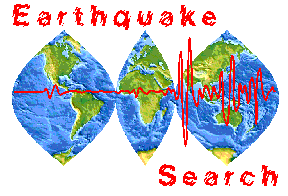
Catalog Source
CATALOG SOURCE: (CAT in Screen Format) Contributing source, or authority. In the following section, the abbreviation of each catalog source is in by parenthesis. The catalog abbreviations are listed in alphabetic order. Catalogs "supplied by NOAA" came to the NEIC from the National Geophysical Data Center of the National Oceanic and Atmospheric Administration (Rinehart and others, 1985).
NOTE: Hypocenters and magnitudes of some earthquakes may differ from catalog to catalog depending on the earthquake catalog from which the information is taken.
-
SIGNIFICANT WORLDWIDE EARTHQUAKES (NOAA):
This catalog is a listing of earthquakes, 2150 B.C. - 1991 (Paula K. Dunbar, Patricia A. Lockridge, and Lowell S. Whiteside, September 1992) supplemented by post-1991 data from the USGS/NEIC. The list includes all events that meet at least one of the following criteria:
-
1. Moderate damage (approximately $1 million
or more)
2. Ten or more deaths
3. Magnitude 7.5 or greater
4. Intensity X or greaterbr>
The explanation of the codes is listed under the AUTHORITY column.
USGS/NEIC, 1973-PRESENT:
(PDE) Catalog of earthquakes located by the
USGS NEIC and its predecessors in the U.S. Coast
and Geodetic Survey, the National Oceanic Survey,
and the Environmental Research Laboratories of the
Department of Commerce. Listings are
from three different publications:
-
(PDE) Preliminary Determinations of
Epicenters, Monthly Listing.
This list is the most complete computation
of hypocenters and magnitudes done
by the USGS NEIC. It is normally produced a
few months after the events occur. The publication
is called "Preliminary" because the "final"
computation of hypocenters for the world
is considered to be the Bulletin of the
Internation Seismological Centre (ISC), which
is produced about two years after the earthquakes
occur. The NEIC PDE program contributes
about one-third off all data used by the ISC.
(PDE-W) PDE Weekly Listing. This file covers the time period following the Monthly data up to four weeks behind the current week. The Weekly PDE data are replaced by the Monthly PDE data as soon as they become available.
(PDE-Q) USGS/NEIC Most Recent Events Daily listing, known as Quick Epicenter Determinatins (QED). These data are extremely preliminary and the parameters of the earthquakes are subject to change as more data are used to relocate the earthquakes. The daily PDE-Q covers the time frame following the Weekly PDE data up to the current date. These data are replaced by the Weekly PDE data.
USGS/NEIC Most Recent Events (PDE-Q):
This contains only PDE-Q events described in the previous section.
SIGNIFICANT U.S. EARTHQUAKES (USHIS):
A catalog of principal earthquakes in
the United States, 1568 -
1989 (Stover, C.W. and Coffman, J. L., 1993).
The catalog is a history of earthquakes which have
magnitudes greater than or equal to 4.5 or
intensity of VI or larger. Exceptions are
Alaska and offshore areas of California,
Oregon, and Washington where
only earthquakes having magnitudes of 5.5 or larger
or intensitites of VI or larger are included.
It does not include earthquakes in Puerto Rico.
the Virgin Islands, American Samoa, Guam, or
Northen Marianas.
CALIFORNIA, 1735 - 1974 (CDMG):
compiled by Real and
others (1978) and Toppozada and others (1984) at
the California Division of Mines and Geology.
This file includes hypocenters from catalogs of the
Seismological Laboratory of the California
Institute of Technology (PAS) and the
Seismological Stations of the University of
California at Berkeley (BRK).
CANADA, 1568 - 1992 (EPB):
compiled by the Earth Physics Branch (EPB)
of Canada, now the Geological Survey of Canada.
Also includes U.S. earthquakes occurring near the
Canadian border. Only the prime hypocenters
(those selected by EPB/GSC as the best solutions
for their earthquakes) are entered into the data
base; in some cases (indicated in the authority
column), these prime hypocenters may have been
computed by an institution other than the EPB/GSC.
INDIA, 1063 - 1984 (INDIA):
This is a combination of four catalogs
(Tandon. A.N. and Srivastava, H.N., 1974;
Chandra, Umesh, 1977; Rao and Rao, 1984;
Srivastava, H.N., and Ramachandran, 1983). See
the authority column for the catalog
identification. The ebtries that could be
identified as duplicates from the four catalogs
have been eliminated from the final listing. The
abbreviations that identify the magnitude source
are listed in the publication by Rao and Rao,
1984.
MEXICO, CENTRAL AMERICA, AND
CARIBBEAN, 1900 - 1979 (NGDC):
compiled at NOAA
(Rinehart and others, 1982).
SOUTH AMERICA, 1471 - 1981 (SISRA):
compiled for Proyecto SISRA,
Programa para la Mitigacion de los
Effectos de los Terremotos en la Region Andina
(Projeft SISRA, Earthquake Mitigation Program in the
Andean Region), edited by
Askew and Algermissen, 1985.
EASTERN, CENTRAL, AND MOUNTAIN STATES OF THE
UNITED STATES, 1534 - 1986 (SRA):
(Stover and others,
1984). An early version of the catalog was
developed under the direction of S.T. Algermissen
for the contiguous 48 states; updated and revised files
have been published in a series of Miscellaneous
Field Studies Maps. The states of Nevada,
California, Oregon, Washington, Alaska, and Hawaii
are not covered in this catalog.

